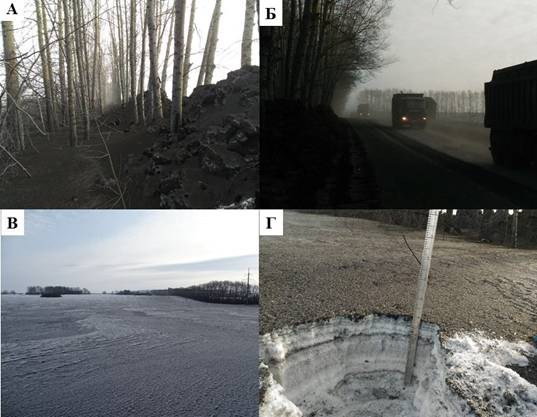Monitoring the aerosol solids deposited in snow in the area affected by the technological road of the Gorlov anthracite mining pit (Novosibirsk region, Russia)
DOI:
https://doi.org/10.31251/pos.v4i1.133Keywords:
coal dust, atmosphere contamination, snow cover, polycyclic aromatic hydrocarbons, open coal mining, cancerogensAbstract
The aim of the study. To monitor and assess the chemical composition of the solid aerosols deposited in the snow in the area affected by the technological road of the Gorlov anthracite mining site.
Location and time of the study. The study was conducted in the Iskitim district of the Novosibirsk region (54.58o N, 83.57o E) in 2018–2020.
Methodology. The content of total solids in snow was measured by gravimetric method after filtering the melted snow sample through the filter with 0.22 µm mesh size. Micromorphology of the solids was studied by using scanning electron microscope Hitachi TM-3000 (Japan) with attached EDS detector console Bruker Quantax 70 for the element analysis of the surface. The carbon content, С/Н and C/N ratios were determined by dry combustion using the СHN-analyzer (Perkin Elmer 2400 Series II, USA). The content and composition of polycyclic aromatic hydrocarbons (PAH) were determined by gas chromatography using Agilent Technologies АТ 6890N with AT 5975N mass-selective detector and AT 7683B autosampler.
Main results. The article presents the results of the three-years long study of the solids accumulated in snow along the technological road in the north of the Gorlov anthracite basin. The influence of the automobile road used for the anthracite transportation was shown to reach as far as 2000 m in all directions. The snow cover was found to accumulate from 1.4 to 1131.6 g/m2 of deposited aerosol solids. Those solids were mostly represented by coal particles, the carbon content ranging 26.5–64.1% and increasing with the distance from the road. The aerosol solids, accumulated in snow, were found to contain significant amounts of PAH, including the carcinogenic ones. In the snow samples collected at 25–2000 m off the road, carcinogenic PAH content was found to be 9–13000 times higher than at the control site remoted from the road.
Conclusion. The presented study helped to elucidate the factors, contributing to decreasing the spread of the anthracite solids during automobile transportation. Such spread can be attained by a) establishing wide multi-storeyed forested protective belts along technological automobile roads; b) compulsory covering of the loads in the coal-transporting vehicles; c) decreasing the speed limit of the vehicles; and d) taking into consideration a wind rose while projecting locations new automobile roads and coal mining spoils.
Downloads

Downloads
Published
How to Cite
Issue
Section
License
Copyright (c) 2021 The Journal of Soils and Environment

This work is licensed under a Creative Commons Attribution 4.0 International License.






